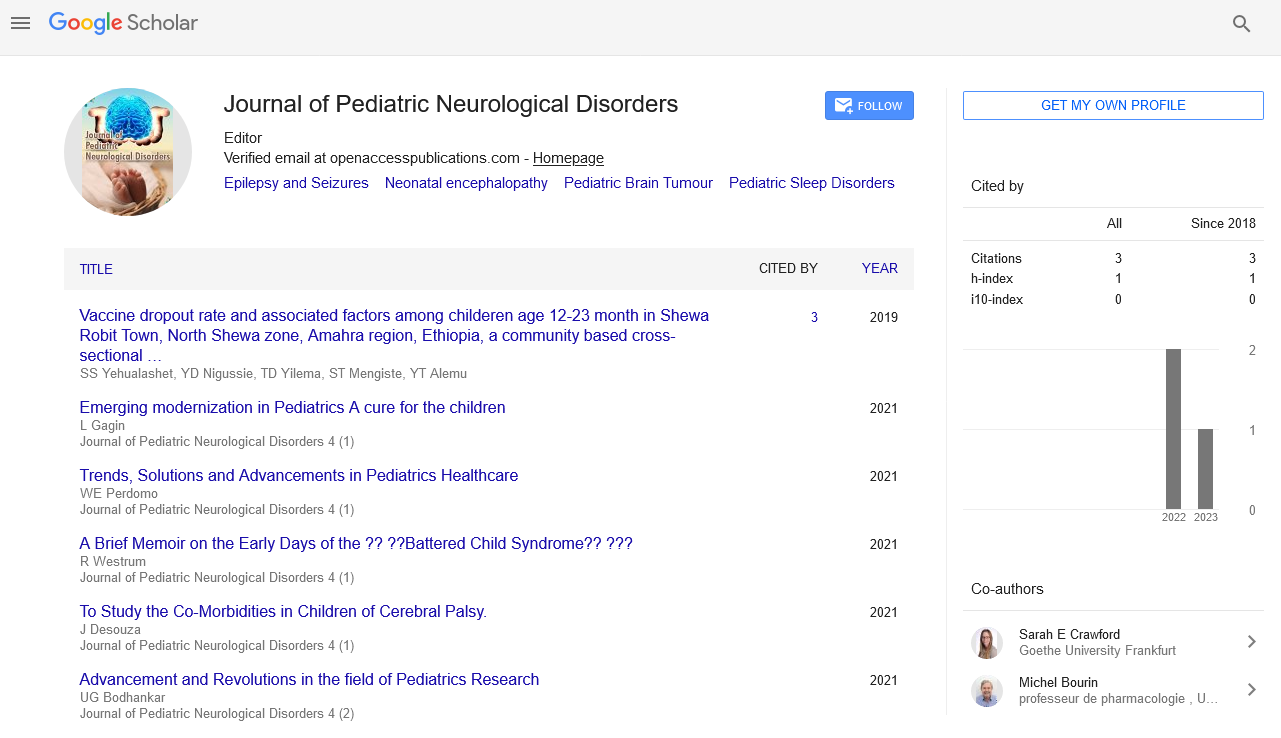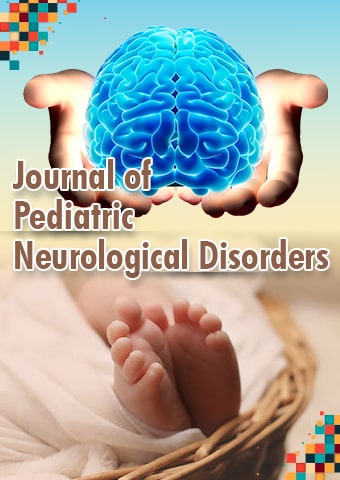Editorial - Journal of Pediatric Neurological Disorders (2023) Volume 6, Issue 2
Preventing Hypoxic Ischemic Encephalopathy Related Brain Damage in Newborns: Update on Mesenchymal Stromal Cells and Umbilical Line Platelets
Thomas Brounwer*
Department of Neurophysiology, Utrecht University
Department of Neurophysiology, Utrecht University
E-mail: thomas@uu.ac.eu
Received: 01-Apr-2023, Manuscript No. pnn-23-97243; Editor assigned: 3-Apr-2023, PreQC No. pnn-23- 97243(PQ); Reviewed: 17-Apr-2023, QC No. pnn-23-97243; Revised: 20- Apr-2023, Manuscript No. pnn-23- 97243; Published: 27-Apr-2023, DOI: 10.37532/pnn.2023.6(2).15-16
Abstract
Neonatal Hypoxic Ischemic Encephalopathy (HIE) causes permanent motor deficit “Cerebral Palsy (CP),” and may result in significant disability and death. Therapeutic hypothermia (TH) had been established as the first effective therapy for neonates with HIE; however, TH must be initiated within the first 6 hours after birth, and the number needed to treat is from 9 to 11 to prevent brain damage from HIE. Therefore, additional therapies for HIE are highly needed. In this review, we provide an introduction on the mechanisms of HIE cascade and how TH and cell therapies such as umbilical cord blood cells and Mesenchyme Stromal Cells (MSCs), especially Umbilical Cord derived MSCs (UC-MSCs), may protect the brain in newborns, and discuss recent progress in regenerative therapies using UC-MSCs for neurological disorders. The brain damage process “HIE cascade” was divided into six stages: (1) energy depletion, (2) impairment of microglia, (3) inflammation, (4) excitotoxity (5) oxidative stress, and (6) apoptosis in capillary, glia, synapse and/or neuron. The authors showed recent 13 clinical trials using UC-MSCs for neurological disorders. The authors suggest that the next step will include reaching a consensus on cell therapies for HIE and establishment of effective protocols for cell therapy for HIE.
Keywords
Hypoxic ischemic encephalopathy • Cerebral palsy • Mesenchyme stromal cells • Umbilical cord
Introduction
Although the prevalence of severe neurological sequelae such as Cerebral Palsy (CP), epilepsy, intellectual disability, respiratory disorders, hearing loss, visual disturbances, hydrocephalus, behavioral issues, and others due to Hypoxic Ischemic Encephalopathy (HIE) has remained at a similar rate over the past several decades, neonatal mortality rates have decreased significantly. An estimated 0.5 to 2/1,000 live births are affected by HIE, which causes severe disability or even death in full-term infants. As of late, Restorative Hypothermia (TH) has been laid out as the principal viable treatment for children with HIE. In any case, TH should be started inside the initial 6 hours of birth, and the number expected to treatment is 9 to 11 to forestall mind harm from HIE. In this way, extra treatments for HIE are profoundly required. In this context, cell therapies such as Umbilical Cord Blood Stem Cells (UCBCs), Bone Marrow Stem Cells (BM-MSCs), and umbilical cord/BM-derived Mesenchymal Stromal Cells (UC/BM-MSCs) have begun to be incorporated into new protocols for preventing ischemic brain damage. It is interesting to note that MSC therapy may also provide promising results for neonates who suffer from acute respiratory distress syndrome in the era of coronavirus disease Due to the complicated HIE cascade, there is a need to overcome "secondary energy failure," as newborns with HIE frequently deteriorate even after appropriate neonatal Cardiopulmonary Resuscitation (CPR), respiratory circulation support therapy, and TH. For instance, the energy demand is much smaller under hypoxia and brain swelling is not as precarious [1, 2].
Significance of MSCs and umbilical line platelets in treatment strategy
One study suggests that hematopoietic stem cells can either differentiate into non lympho hematopoietic cells such as neurons or microglia or stimulate neurogenesis. However, it is unclear whether this is significantly effective for neonates with HIE [3, 4]. We reported UC-MSCs could enhance neurogenesis in injured neurons with high expression of growthassociated protein 43 and confirmed elongated processes in injured neurons. In addition, we have previously demonstrated that UC-MSCs partially exert their neuroprotective effects through the secretion of BDNF and HGF by encouraging the death or apoptosis of damaged neurons [5]. TH, on the other hand, must be started within the first six hours of birth. The acute stages of HIE were primarily protected by TH. Cell therapy, on the other hand, may prolong the therapeutic window over acute stages by reducing apoptosis and oxidative stress and enhancing the regenerative process. Besides, cell treatments, for example, UCBCs and UCMSCs are being integrated into new supportive of tools for assurance against ischemic mind harm in some nations. It was published that first report of an autologous UCBC phase 1 clinical study for newborns with HIE55 [6, 7]. Twentythree infants were cooled and given cells. Vital signs, including oxygen saturation, were similar before and after infusions in the first postnatal hours. Median collection and infusion volumes were 36 and 4.3 mL, respectively. Mortality and oral feeds at discharge were similar for cell recipients and concurrently cooled infants in the hospital. We administered autologous UCBC therapy for neonatal HIE for the first time in Japan in 2014 [8]. In 2014, it was established the Neonatal Encephalopathy Consortium, Japan research group for autologous UCBC therapy for neo-natal HIE, and began using autologous UCBC therapy for neonatal HIE. Thirteen of 18 cell recipients, or 74 percent, and 19 of 46 concurrently cooled infants, or 41 percent, had known outcomes at one year. This is a pilot study to determine whether and how safe UCBC therapy for neonates with HIE is; the study is an open-mark, single-bunch task.
The select experiment models for our autologous UCBC study are equivalent to the consideration/ prohibition rules for TH in Japan [9, 10].
Conclusion
Since the foundation of agreement recommending that TH ought to be presented for infant HIE, it is as yet testing to forestall mind harm from confounded fountain of HIE. A consensus on cell therapies for HIE and the development of efficient cell therapy protocols are suggested as the next steps.
References
- Jacobs S, Hunt R, Tarnow Mordi W et al. Cooling for newborns with hypoxic ischemic encephalopathy. Cochrane Database Syst Rev. 4, CD003311 (2007).
- Nabetani M, Shintaku H, Hamazaki T. Future perspectives of cell therapy for neonatal hypoxic-ischemic encephalopathy. Pediatr Res. 83, 356-363 (2018).
- Khoury M, Cuenca J, Cruz FF et al. Current status of cell-based therapies for respiratory virus infections: applicability to COVID-19. Eur Respir J. 55, 2000858 (2020).
- Perlman JM. Intervention strategies for neonatal hypoxic ischemic cerebral injury. Clin Ther. 28, 1353-1365 (2006).
- Koyama, Kenji. Histopathological study of encephalomalacia in neonatal calves and application of neuronal and axonal degeneration marker. Journal of Veterinary Medical Science. 80, 1116-1124 (2018).
- Nabetani M, Okada Y, Kawai S et al. Neural activity and the levels of high energy phosphates during deprivation of oxygen and/or glucose in hippocampal slices of immature and adult rats. Int J Dev Neurosci. 13, 3-12(1995).
- Olney JW, Sharpe LG. Brain lesions in an infant rhesus monkey treated with monosodium glutamate. Science. 166, 386-388 (1969).
- Olney JW, Ho OL. Brain damage in infant mice following oral intake of glutamate, aspartate or cysteine. Nature. 227, 609-611(1970).
- Kirino T. Delayed neuronal death in the gerbil hippocampus following ischemia. Brain Res. 239, 57-69 (1982).
- Delpy DT, Gordon RE, Hope PL. Noninvasive investigation of cerebral ischemia by phosphorus nuclear magnetic resonance. Pediatrics. 70, 310-313 (1982).
Indexed at, Crossref, Google Scholar
Indexed at Crossref, Google Scholar
Indexed at, Crossref, Google Scholar
Indexed at, Crossref, Google Scholar
Indexed at, Crossref, Google Scholar
Indexed at, Crossref, Google Scholar
Indexed at, Crossref, Google Scholar
Indexed at, Crossref, Google Scholar
Indexed at, Crossref, Google Scholar

